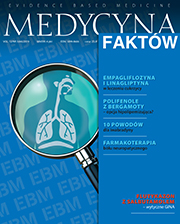The use of cilostazol in peripheral arterial disease – indications and controversies Review article
Main Article Content
Abstract
Atherosclerosis is a systemic disease. Coronary heart disease often coexists with peripheral atherosclerosis, the most common form of which is arterial disease of the lower extremities. The basis of treatment of atherosclerosis is the control of risk factors, effective treatment of hypertension, diabetes, lipid disorders, often also the use of drugs affecting the coagulation system. These treatment strategies have a positive impact on patients’ prognosis. However in the case of atherosclerosis of the lower limbs, intermittent claudication is a common everyday problem. Current European guidelines on the diagnosis and treatment of peripheral atherosclerosis indicate cilostazol as the only effective symptom drug, prolonging the distance of claudication. Cilostazol has antiaggregative effects, atherosclerosis patients often have indications for the use of several drugs affecting the activity of the coagulation system. The authors of the article attempt to position cilostazol at a time when the paradigms of anticoagulation are dynamically changing.
Article Details
Copyright © by Medical Education. All rights reserved.
References
2. Aboyans V., Ricco J.B., Bartelink M.L., Bjorck M.: Wytyczne ESC dotyczące rozpoznawania i leczenia chorób tętnic obwodowych w 2017 roku, przygotowane we współpracy z ESVS. Kardiologia Polska 2017; 75(11): 1065-1160. DOI: 10.5603/KP.2017.0216.
3. Gerhard-Herman M.D., Gornik H.L., Barrett C. et al.: 2016 AHA/ACC Lower Extremity PAD Guideline: Executive Summary. Circulation 2017; 135: e686-e725.
4. [online: http://www.mpz.mz.gov.pl].
5. Norgren L., Hiatt W.R., Dormandy J.A. et al.: Konsensus dotyczący postępowania w chorobie tętnic obwodowych (TASC II). Eur. J. Vasc. End. Surg. 2007; 33(supl. 1): D1-D80.
6. Barylski M., Mamcarz A., Siebert J. et al.: Nowy paradygmat leczenia przeciwzakrzepowego chorób miażdżycowych. Choroby Serca i Naczyń 2019; 6(1): 1-16.
7. Eikelboom J.W., Connolly S., Bosch J. et al.: Rivaroxaban with or without aspirin in stable cardiovascular disease. N. Engl. J. Med. 2017; 377(14): 1319-1330.
8. Chudej J., Ziaja D.: Cilostazol w leczeniu niedokrwienia kończyn dolnych. Chirurgia Polska 2014; 16(1): 6-11.
9. Wierzchowski P., Migdalski A., Jawień A.: Zastosowanie cilostazolu w chromaniu przestankowym u chorych z przewlekłym niedokrwieniem kończyn dolnych. Acta Angiol. 2014; 20(3): 101-105.
10. Hashimoto A., Miyakoda G., Hirose Y. et al.: Activation of endothelial nitric oxide synthase by cilostazol via a cAMP/protein kinase A- and phosphatidylinositol 3-kinase/Akt-dependent mechanism. Atherosclerosis 2006; 189: 350-357.
11. Hori A., Shibata R., Morisaki K. et al.: Cilostazol stimulates revascularisation in response to ischaemia via an eNOS-dependent mechanism. Eur. J. Vasc. Endovasc. Surg. 2012; 43: 62-65.
12. Kęsik J.J., Zubilewicz T.: Cilostazol. Via Medica, Gdańsk 2015.
13. Okuda Y., Kimura Y., Yamashita K.: Cilostazol. Cardiovasc. Drug Rev. 1993; 11: 451-465.
14. Robless P., Mikhailidis D.P., Stansby G.P.: Cilostazol for peripheral arterial disease. Cochrane Database Syst. Rev. 2008; 1: CD003748.
15. Thompson P.D., Zimet R., Forbes W.P., Zhang P.: Meta-analysis of results from eight randomized, placebo-controlled trials on the effect of cilostazol on patients with intermittent claudication. Am. J. Cardiol. 2002; 90: 1314-1319.
16. Rendell M., Cariski A.T., Hittel N., Zhang P.: Cilostazol treatment of claudication in diabetic patients. Curr. Med. Res. Opin. 2002; 18: 479-487.
17. de Franciscis S., Gallelli L., Battaglia L. et al.: Cilostazol prevents foot ulcers in diabetic patients with peripheral vascular disease. Int. Wound J. 2013 [Epub ahead of print].
18. Beebe H.G., Dawson D.L., Cutler B.S. et al.: A new pharmacological treatment for intermittent claudication: results of a randomized, multicenter trial. Arch. Intern. Med. 1999; 159: 2041-2050.
19. Lee C., Nelson P.R.: Effect of cilostazol prescribed in a pragmatic treatment program for intermittent claudication. Vasc. Endovascular Surg. 2014; 48: 224-229.
20. Shalhoub J., Davies A.H., Franklin I.J.: Cilostazol may improve outcome in critical limb ischemia. Int. Angiol. 2009; 28: 363-366.
21. Resnick K.A., Gordon I.L.: Effects of cilostazol on arterial wound healing: a retrospective analysis. Ann. Vasc. Surg. 2014; 28: 1513-1521.
22. Iida O., Yokoi H., Soga Y. et al.: Cilostazol reduces angiographic restenosis after endovascular therapy for femoropopliteal lesions in the Sufficient Treatment of Peripheral Intervention by Cilostazol study. Circulation 2013; 127: 2307-2315.
23. Uchiyama S., Demaerschalk B.M., Goto S. et al.: Stroke prevention by cilostazol in patients with atherothrombosis: meta-analysis of placebo- controlled randomized trials. J. Stroke Cerebrovasc. Dis. 2009; 18: 482-490.
24. Dinicolantonio J.J., Lavie C.J., Fares H. et al.: Meta-analysis of cilostazol versus aspirin for the secondary prevention of stroke. Am. J. Cardiol. 2013; 112: 1230-1234.
25. Qian Y., Bi Q.: Systematic study of cilostazol on secondary stroke prevention: a meta-analysis. Eur. J. Med. Res. 2013; 18: 53.

